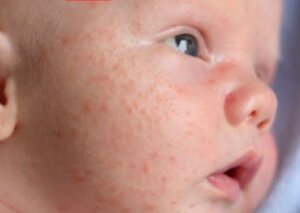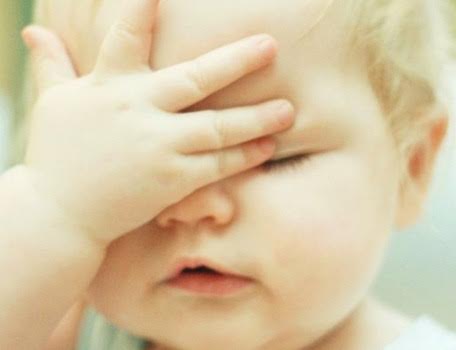What is Infant Acne?

In the first or second month of life of our little ones, small outbreaks usually appear on their little faces that can scare us a lot. Immediately, we imagine that it’s an allergy or a reaction to some foreign element, but the good news is that, generally, it’s a phenomenon called infant acne.
These white or yellowish-colored pustules commonly appear on the nose, cheeks, forehead, back, and chin area. We always think of a baby’s face as being as soft as silk, but when these pimples appear, we worry a lot and wonder how they’ll heal. What happens if I try to remove them? Will they leave a mark? Are they uncomfortable or itchy?
Infant acne occurs in 40% of newborns.
Especially in children who are exclusively breastfed, as mothers, we often believe that we’re the cause of the problem, that we’re eating something that’s hurting them, or that we shouldn’t continue breastfeeding them. In these cases, the first thing you have to do is to stop doubting the tremendous value of your maternal milk because it’s perfect for your little one.
Acne neonatorum, as it’s also known, occurs in 40% of newborns. It happens for a simple reason: The accumulation of oil that gets trapped in their pores. This way, with a simple explanation, we can start worrying and thinking about possible alternatives to help them solve this problem.
Infant acne under the spotlight

On some occasions, babies already have several pimples surrounded by reddish skin when they come out of their mother’s tummy, i.e., it’s very similar to infant acne. This is very similar to the acne that appears in adolescence. They tend to be more visible if they’re annoyed, hot, irritated by saliva, rough clothes, regurgitated milk, or washed with strong soaps.
If accompanied by other lesions, it may be eczema or cradle cap.
However, it’s important to clarify that if the child is born with these harmless lesions on their face and they disappear within a few days, it’s acne miliaria. However, if they’re accompanied by rashes or flaking on other parts of the body, it could be other conditions such as cradle cap.
Acne miliaria is very common and is formed due to the accumulation of oil in the baby’s pores. Cradle cap or seborrheic dermatitis is a condition of the epidermis that causes red, slightly scaly patches to appear on the scalp, forehead, and face. The incidence of cradle cap is variable and can affect up to 13% of babies according to the Spanish Association of Pediatrics.
What causes infant acne?
To date, there’s no precise answer to tell us the true origin of this cutaneous phenomenon. For many, many years, experts have said that neonatal acne is due to the transfer of hormones from the mother to her baby, which occurs at the end of the gestational stage.
However, several groups of specialists have tried to analyze the influence of other factors on this problem, but they haven’t been able to reach an accurate conclusion. Some insist that the intake of certain medications, either by the baby or by the mother, influences its appearance.
Infant acne disappears after a few weeks without any special treatment.
These pimples will only last a few weeks, although they’re likely to reappear. Of course, if it doesn’t improve in a couple of months, consult your pediatrician for guidance in this situation.
And in the meantime, what can you do?

To improve the condition of your child’s complexion, you’ll need to take into account these recommendations on what to do and what not to do:
- Avoid special remedies without prior medical consultation.
- Don’t put any ointment, cream, or oil on the affected areas, as these can make it worse.
- Don’t try to stimulate the area with deep cleansing, as it will become irritated.
- Washing their skin with cool water and mild soap will suffice.
- Dry them very gently.
- Don’t be anxious about this issue, as these rashes don’t bother your baby, nor do they itch. So be very patient, they’ll disappear little by little.
After 6 months of age
The manifestations of this condition after six months of age attract more attention from experts. Generally, it’s a sign that they’ll suffer again in adolescence.
Infantile acne should be treated with drugs recommended by a doctor and, above all, don’t try to remove them because they run the risk of becoming infected.
It’s our responsibility to take care of these special beings who’ve come to bless our lives. Therefore, we must put our whole heart into helping them and seek professional advice when necessary. They deserve all our love because they gave us the honor of becoming parents.
In the first or second month of life of our little ones, small outbreaks usually appear on their little faces that can scare us a lot. Immediately, we imagine that it’s an allergy or a reaction to some foreign element, but the good news is that, generally, it’s a phenomenon called infant acne.
These white or yellowish-colored pustules commonly appear on the nose, cheeks, forehead, back, and chin area. We always think of a baby’s face as being as soft as silk, but when these pimples appear, we worry a lot and wonder how they’ll heal. What happens if I try to remove them? Will they leave a mark? Are they uncomfortable or itchy?
Infant acne occurs in 40% of newborns.
Especially in children who are exclusively breastfed, as mothers, we often believe that we’re the cause of the problem, that we’re eating something that’s hurting them, or that we shouldn’t continue breastfeeding them. In these cases, the first thing you have to do is to stop doubting the tremendous value of your maternal milk because it’s perfect for your little one.
Acne neonatorum, as it’s also known, occurs in 40% of newborns. It happens for a simple reason: The accumulation of oil that gets trapped in their pores. This way, with a simple explanation, we can start worrying and thinking about possible alternatives to help them solve this problem.
Infant acne under the spotlight

On some occasions, babies already have several pimples surrounded by reddish skin when they come out of their mother’s tummy, i.e., it’s very similar to infant acne. This is very similar to the acne that appears in adolescence. They tend to be more visible if they’re annoyed, hot, irritated by saliva, rough clothes, regurgitated milk, or washed with strong soaps.
If accompanied by other lesions, it may be eczema or cradle cap.
However, it’s important to clarify that if the child is born with these harmless lesions on their face and they disappear within a few days, it’s acne miliaria. However, if they’re accompanied by rashes or flaking on other parts of the body, it could be other conditions such as cradle cap.
Acne miliaria is very common and is formed due to the accumulation of oil in the baby’s pores. Cradle cap or seborrheic dermatitis is a condition of the epidermis that causes red, slightly scaly patches to appear on the scalp, forehead, and face. The incidence of cradle cap is variable and can affect up to 13% of babies according to the Spanish Association of Pediatrics.
What causes infant acne?
To date, there’s no precise answer to tell us the true origin of this cutaneous phenomenon. For many, many years, experts have said that neonatal acne is due to the transfer of hormones from the mother to her baby, which occurs at the end of the gestational stage.
However, several groups of specialists have tried to analyze the influence of other factors on this problem, but they haven’t been able to reach an accurate conclusion. Some insist that the intake of certain medications, either by the baby or by the mother, influences its appearance.
Infant acne disappears after a few weeks without any special treatment.
These pimples will only last a few weeks, although they’re likely to reappear. Of course, if it doesn’t improve in a couple of months, consult your pediatrician for guidance in this situation.
And in the meantime, what can you do?

To improve the condition of your child’s complexion, you’ll need to take into account these recommendations on what to do and what not to do:
- Avoid special remedies without prior medical consultation.
- Don’t put any ointment, cream, or oil on the affected areas, as these can make it worse.
- Don’t try to stimulate the area with deep cleansing, as it will become irritated.
- Washing their skin with cool water and mild soap will suffice.
- Dry them very gently.
- Don’t be anxious about this issue, as these rashes don’t bother your baby, nor do they itch. So be very patient, they’ll disappear little by little.
After 6 months of age
The manifestations of this condition after six months of age attract more attention from experts. Generally, it’s a sign that they’ll suffer again in adolescence.
Infantile acne should be treated with drugs recommended by a doctor and, above all, don’t try to remove them because they run the risk of becoming infected.
It’s our responsibility to take care of these special beings who’ve come to bless our lives. Therefore, we must put our whole heart into helping them and seek professional advice when necessary. They deserve all our love because they gave us the honor of becoming parents.
All cited sources were thoroughly reviewed by our team to ensure their quality, reliability, currency, and validity. The bibliography of this article was considered reliable and of academic or scientific accuracy.
- Comité editorial de En Familia. (2022). Acné neonatal. En Familia AEP. Recuperado de: https://enfamilia.aeped.es/edades-etapas/acne-neonatal
- Godínez J. A., & Vidaurri-De la Cruz, H. (2021). Acné en el recién nacido. Boletín Médico del Hospital Infantil de México, 78(5). Recuperado de: https://doi.org/10.24875/bmhim.20000327
- Herane M., Ando I. (2003). Acne in Infancy and Acne Genetics. Karger, 206:24-28. Recuperado de: https://www.karger.com/Article/Abstract/67819
- Lizardo Castro, G. A., & Aguilar Gutiérrez, K. F. (2021). Acné pediátrico. Acta Pediátrica de México, 42(4), 177. Recuperado de: https://doi.org/10.18233/apm42no4pp177-1912099
- Melchor K., Montes J., Muñoz N., Toledo M., Mena C., Valencia A. (2019). Acné neonatal. Dermatología Revista Mexicana, 63(Supl. 1), S101-S103. Recuperado de: https://dermatologiarevistamexicana.org.mx/article/acne-neonatal/
- Pozo, T., Mínguez, B. (2021). Dermatitis atópica y dermatitis seborreica. Pediatría Integral, 25(3), 119-127. Recuperado de: https://www.pediatriaintegral.es/publicacion-2021-05/dermatitis-atopica-y-dermatitis-seborreica/
This text is provided for informational purposes only and does not replace consultation with a professional. If in doubt, consult your specialist.








